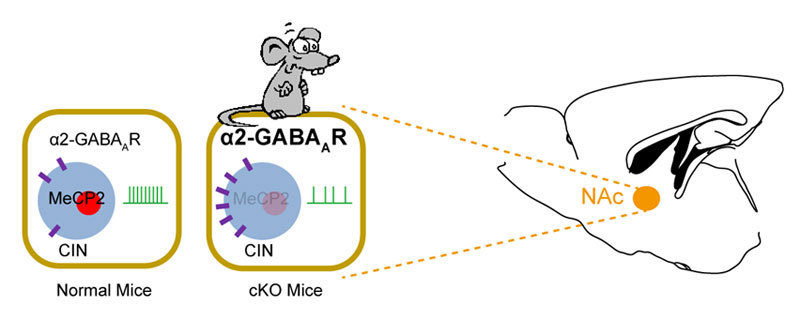RTT is an autism spectrum disorder that affects nearly 1 in 10 000 females. Patients with RTT exhibit a broad range of phenotypes including impaired social interactions, motor abnormalities, cognitive defects and epilepsy. Recently, a team headed by Prof.LI Xiaoming, School of Brain Science and Brain Medicine, Zhejiang University School of Medicine, made a major breakthrough in the study of Rett syndrome. The study, published in the June 18th issue of eLife, found new cellular and molecular mechanisms mediating the pathogenesis of Rett syndrome.
For the past four years Professor LI's team has focused on a protein called MeCP2, which encoded by the MECP2 gene, a transcriptional regulator whose mutations cause Rett syndrome (RTT).Researchers showed that Mecp2 gene deficiency in cholinergic interneurons of the nucleus accumbens (NAc) dramatically impaired fear learning. They further found that spontaneous activity of cholinergic interneurons in Mecp2-deficient mice decreased, mediated by enhanced inhibitory transmission via α2-containing GABAA receptors. With MeCP2 restoration, opto- and chemo-genetic activation, and RNA interference in ChAT-expressing interneurons of the NAc, impaired fear retrieval was rescued.

“There is still a long way to go in transferring our research to clinical treatment of fear related disorders and RTT,” said Prof. LI, “We have focused on MeCP2 for several years and found the cellular and molecular mechanisms underlying impaired social, anxiety- and depression-like behaviors, elevated epilepsy susceptibility as well as abnormal learning and memory in Mecp2-deficient mice, which provide attractive molecular targets for treatment of RTT.”
“The study uses a set of elegant experiments to reduce this protein, alter activity, and alter inhibitory receptor function in acetylcholine expressing neurons in a brain region involved with emotional behavior to provide mechanistic insight into fear learning processes.” Commented editor of eLife, Mary Kay Lobo. ,“This study has implications for potential mechanisms and brain cell subtypes relevant to fear-related disorders.”
Please refer to the study at https://elifesciences.org/articles/55342